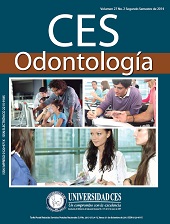Resistencia a la fractura de dientes debilitados radicularmente rehabilitados con diferentes materiales
Resumen
Introducción y objetivo:
La preservación y restauración de dientes debilitados radicularmente se ha considerado como un procedimiento poco predecible debido a que existen factores que predisponen al fracaso. Esta condición se presenta frecuentemente y una alternativa para su rehabilitación es reforzar la superficie radicular para mejorar la estabilidad y retención del retenedor. El objetivo de este estudio fue evaluar la resistencia a la fractura de dientes debilitados radicularmente reconstruidos con ionómero de vidrio en combinación con diferentes retenedores comparados con raíces debilitadas sin refuerzo radicular.
Materiales y métodos:
60 premolares uniradiculares con similares características fueron seleccionados y divididos aleatoriamente en 6 grupos, 30 dientes fueron internamente debilitados a 1mm y posteriormente reforzados con ionómero de vidrio. Los especímenes fueron sometidos a carga compresiva en una maquina de ensayos
universal Instrom con una angulación de 45°. Posteriormente se identificaron los sitios de fractura con ayuda de una lupa 4X de lente convergente a una distancia de 25 cm.
Resultados:
Resultados indicaron diferencias estadísticamente significativas en relación a la condición radicular (P<0.05), demostrando que dientes con refuerzo radicular no mejora considerablemente la resistencia a la fractura.
Conclusión:
La conservación de la estructura dentaria es más importante que el tipo de refuerzo con materiales dentales. Las características físicas y químicas de los ionómeros permiten su empleo en zonas de socavado, sin aumentar la resistencia compresiva final de la estructura dentaria, brindando únicamente estabilidad del retenedor.
Descargas
Referencias bibliográficas
Las especialidades odontológicas en la práctica general. Barcelona: Editorial labor S. A; 1987. p 565-575.
2. Sorensen JA, Martinoff JT. Intracoronal reinforcement and coronal coverage: a study of endodontically
treated teeth. J Prosthet Dent. 1984;51(6):780-784.
3. Standlee JP, Caputo AA. The retentive and stress distributing properties of split threaded endodontic
dowels. J Prosthet Dent. 1992;68(3):436-442.
4. Caputo AA, Standlee JP. Biomechanics in clinical dentistry. Berlin: Quintessence Publishing; 1987;21-27.
5. Craig RG, Farah JW. Stress analysis and design of single restorations and fixed bridges. Oral Sci Rev.
1977;10:45-74.
6. Lui JL. A technique to reinforce weakened roots with post canals. Endod Dent Traumatol. 1987;3(6):310-
314.
7. Lui JL. Composite resin reinforcement of flared canals using light-transmitting plastic post. Quintessence
Int. 1994;25(5):313-319.
8. Christensen GJ. Posts and cores: state of the art. J Am Dent Assoc. 1998; 129(1):96-97.
9. Chalifoux PR. Esthetic restoration of endodontically treated teeth: factors that affect prognosis. J Esthet
Dent. 1998;10(2):75-83.
10. Mendonza DB, Eakle S, Kahl EA, Ho R. Root reinforcement with resin-bonded preformed post. J
Prosthet Dent. 1997;78(1):10-14.
11. Saupe WA, Gluskin AH, Radke RA. A comparative study of fracture resistance between morphlogic
dowel and cores and resin-reinforced dowel system in the intraradicular restoration of structurally
compromised roots. Quintessence Int. 1996; 27(7): 483-491.
12. Marchi GM, Paulillo LAMS, Pimenta LAF, Lima FAP. Effect of different filling materials in combination
with intraradicular posts on the resistance to fracture of weakened roots. J Oral Rehabilitation.
2003;30(6):623-629.
13. Bortoluzzi EA, Souza EM, Reis JM, Esberard RM, Tanomaru-Filho M. Fracture strength of bovine
incisors after intra-radicular treatment with MTA in an experimental immature tooth model. Int Endod J.
2007;40(9):684-691.
14. Carvalho CA, Valera MC, Oliveira LD, Camargo CH. Structural resistance in immature teeth using root
reinforcements in vitro. Dent Traumatol. 2005; 21(3): 155-159.
15. Melo MP, Valle AL, Pereira JR, Bonachela WC, Pegoraro LF, Bonfante G. Evaluation of fracture
resistance of endodontically treated teeth restored with prefabricated posts and composites with varying
quantities of remaining coronal tooth structure. J Appl Oral Sci. 2005;13(2):141-146.
16. Mattos CM, Las Casas EB, Dutra IG, Sousa HA, Guerra SM.Numerical analysis of the biomechanical
behaviour of a weakened root after adhesive reconstruction and post-core rehabilitation. J Dent.
2012;40(5):423-432.
17. Whang SB.Resistance to root fracture of dowel channels with various thicknesses of buccal dentin
walls. J Prosthet Dent. 1985;53(4):496-500.
18. Fernandes AS, Dessai GS. Factors affecting the fracture resistance of post-core reconstructed teeth:
a review. Int J Prosthodont. 2001 Jul-Aug;14(4):355-363.
19. Morgano SM. Restoration of pulpless teeth application of traditional principles in present and future
contestexts. J Prosthet Dent. 1996;75(4):375-380.
20. Trope M, Maltz DO, Tronstad L. Resistant to fracture of restored endodontically treated teeth. Endod
Dent Traumatol. 1985;1(3):108-111.
21. Asmussen E, Peutzfeldt A, Heitmann T. Stiffness, elastic limit, and strength of newer types of
endodontic posts. J Dent. 1999;27(4): 275-278.
22. Fraga RC, Chaves BT, Mello GS, Siquiera JF Jr. Fracture resistance of endodontically treated roots
after restoration. J Oral Rehabil. 1998;25(11): 809-813.
23. Akkayan B, Gulmez T. Resistance to fracture of endodontically treated teeth restored with different
post systems.J Prosthet Dent 2002;87:431–437.
24. Fokkinga WA, Kreulen CM, Vallittu PK,Creugers NH. A structured analysis of in vitro failure loads and
failure modes of fiber, metal, and ceramic post-and-coresystems. Int J Prosthodont 2004;17:476–482.
25. Willershausen B, Tekyatan H, Krummenauer F, Briseno Marroquin B. Survivalrate of endodontically
treated teeth in relation to conservative vs post insertion techniques—a retrospective study. Eur J Med
Res 2005;10:204–208.
26. Heydecke G, Butz F, Strub JR. Fracture strength and survival rate of endodontically treated maxillary
incisors with approximal cavities after restoration with different posts and core systems: an in vitro study.
J Dent. 2001;29(6): 427-433.
27. Martins LR. Avaliação da resistência à fratura de raízes debilitadas reconstruídas morfológicamente
com materiais adesivos. Faculdade de Odontología da UNICAMP; 1995.
28. Bex RT, Parker MW, Judkins JT, Pelleu GB Jr. Effect of dentinal bonded resin post-core preparations
on resistance to vertical root fracture. J Prosthet Dent. 1992;67(6):768-672.
29. Assif D, Gorfil C. Biomechanical considerations in restoring endodontically treated teeth. J Prosthet
Dent. 1994 Jun;71(6):565-567.
30. Isidor F, Ödman P, Brondum K. Intermittent loading of teeth restored using prefabricated carbon fiber
posts. Int J Prosthodont. 1996; 9:131-136.
31. Dean JP, Jeansonne BG, Sarkar N. In vitro evaluation of a carbon fiber post. J Endod. 1998; 24:807-
810.
32. Zogheib LV, Pereira JR, do Valle AL, de Oliveira JA, Pegoraro LF. Fracture resistance of weakened
roots restored with composite resin and glass fiber post.Braz Dent J. 2008;19(4):329-333.
33. Fredriksson M, Astback J , Pamenius M, Arvdison K. A retrospective study of 236 patients with teeth
restored by carbon fiber-reinforced epoxy resin posts. J Prosthet Dent. 1998; 80:151-157.
34. Ferrari M, Vichi A, Garcia-Godoy F. Clinical evaluation of fiber-resin forced epoxy-resin posts and cast
post-an-care. Am J Dent. 2000; 13:15B-18B.
35. Lassila LP, Tanner J, Le Bell AM, Narva K, Vallittu PK. Flexural properties of fiber reinforced root canal
posts. Dent Mater. 2004 Jun;20(1)29-36.
36. Milot P, Stein S. Root fracture in endodontically treated teeth related to post selection and crown
desing. J Prosthet Dent. 1992 Sep;68(2):428-435.
37. Eskitascioglu G, Belli S, Kalkan M. Evaluation of two post core system using two different methods
(fracture strength test and a finite elemental stress analysis). J Endod. 2002 sep;28(9):629-633.
Descargas
Publicado
Cómo citar
Número
Sección
| Estadísticas de artículo | |
|---|---|
| Vistas de resúmenes | |
| Vistas de PDF | |
| Descargas de PDF | |
| Vistas de HTML | |
| Otras vistas | |



